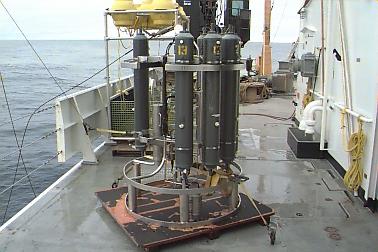WHAT'S NEW:
BACKGROUND:
Mission
Project Description
Cruise Plans:
Participants
Technology (ROV, ships, etc.)
Future Plans
Results:
1998 NeMO Cruise
Axial 1998 "Eruption"
Logbook
June 17, 1999
June 17, 1999
Contents:
- News from Wecoma
- Participant Perspective
- Logbook from Teacher at Sea
- Question/Answer from shore to sea
Wecoma Science Report
Weather has been uncommonly good, with little wind and
sea, so we've accomplished a lot.
Wecoma
arrived Thursday evening and made two
 CTD casts
over the
new lava flow.
Hydrothermal activity is still plentiful,
with optical anomalies comparable to last year. Visual inspection of the
filters suggests most of the particles are sulfur/biogenic, not metal
sulfides. Several people have said they can smell sulfur impregnated in
the mooring lines we've collected. Height of the maximum plume horizon
seems to be 50-100 m less than last year, suggesting a diminishment in the
heat flux.
CTD casts
over the
new lava flow.
Hydrothermal activity is still plentiful,
with optical anomalies comparable to last year. Visual inspection of the
filters suggests most of the particles are sulfur/biogenic, not metal
sulfides. Several people have said they can smell sulfur impregnated in
the mooring lines we've collected. Height of the maximum plume horizon
seems to be 50-100 m less than last year, suggesting a diminishment in the
heat flux.
Listing of all Science News postings
Life at Sea: Participant Perspective
Not available today.
Listing of all Perspectives postings
Teacher At Sea Logbook
Report #2
Day 2, Thursday 6/17/99
After a full day of cruising at 12 knots we reached the Axial Volcano (9pm). The crew and scientists moved into action. We deployed a carousel for sea-surface sampling.
 The Conductivity Temperature Depth recorder (CTD) is an oceanographic
sampling instrument with electronic sensors to continuosly measures
salinity, temperature and depth. The rosette contains Niskin bottles that
are large PVC plastic cylinders with spring loaded caps that close at both
ends. As the stainless steel frame rosette is lowered, the end caps are
open and water can pass through. Sharon Walker manned the control panel
that triggered each bottle to close at the desired depth and take a
sample. These bottles were then returned to the surface and water samples
were removed for analysis.
The Conductivity Temperature Depth recorder (CTD) is an oceanographic
sampling instrument with electronic sensors to continuosly measures
salinity, temperature and depth. The rosette contains Niskin bottles that
are large PVC plastic cylinders with spring loaded caps that close at both
ends. As the stainless steel frame rosette is lowered, the end caps are
open and water can pass through. Sharon Walker manned the control panel
that triggered each bottle to close at the desired depth and take a
sample. These bottles were then returned to the surface and water samples
were removed for analysis.
Everyone was anxious to receive seawater samples from the plume region. The collection continues through the night.
Tomorrow we will be retrieving instruments that have been suspended from the seafloor for a year. Check back tomorrow to find out if we are able to recover these instruments...
Fair seas,
Ms. Deck
Logbook of all Teacher At Sea postings
Questions & Answers
(oar.pmel.vents.webmaster@noaa.gov)